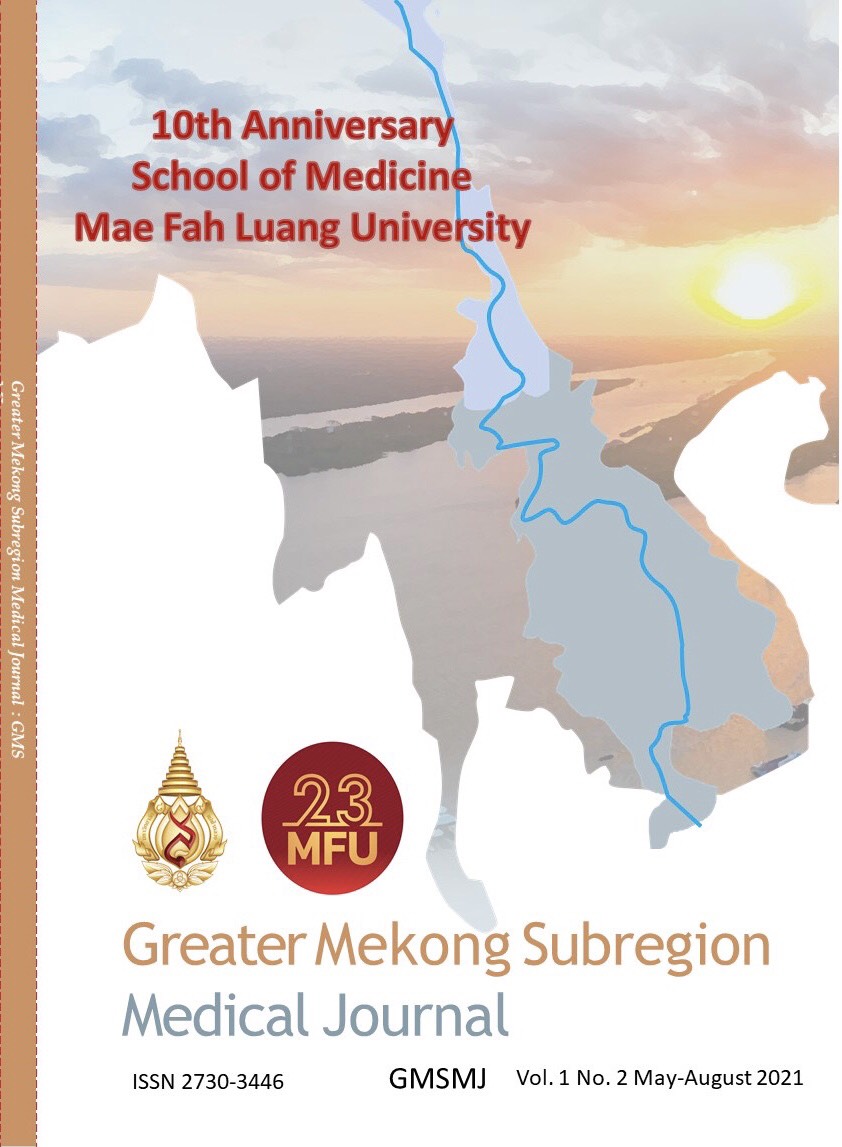Preparation of Glass-Ceramic Biomaterial from Cow bone and Thai Mollusk shells
Keywords:
Hydroxyapatite, Biomaterial, Cockle shell, Bioceramic, BioglassAbstract
Background: Hydroxyapatite material has excellent biocompatibility with the human body trust it has poor mechanical properties. Bioglass addition can be solving this problem. Glass-ceramic biomaterial from cow bone and Thai mollusk shells is a new material for repair the broken bone.
Objective: The purpose of this research is preparation of glass-ceramic biomaterial form cow bone and Thai mollusk shells, and to investigate their characteristics and properties.
Methods: Nano HA powder was prepared by thermal method for heating up to 950°C and ground with highspeed pot mill, beside the calcium phosphate glass was prepared by melted the mixture of CaO-P2O5-Na2O at 1000°C, quenched and ground to fine powder by high speed pot mill. Then mix two type of powder in the various ratio. Samples of the composite were formed by a hydraulic press machine and sintered at temperature of 1300°C for 2 h in an electric furnace. Characterization by FTIR, XRD, SEM/EDX and UTM machine.
Results: The results from FTIR and XRD confirmed the functional groups and composition phase of HA powder that has the ion stretching vibration of hydroxyl group (OH-), carbonate (CO32-), and phosphate groups (PO43-) were also observed around 1045 and 560 cm-1 respectively. XRD measurement showed that the ceramic contains hydroxyapatite crystals with β-tricalcium phosphate, calcium oxide and amorphous CaPO4 phase. SEM measurement shows the porous, HA particles and amorphous phase. Mechanical property measurements show that the glass-ceramic contains flexural stress of 55.09 MPa.
Conclusion: In this experiment, hydroxyapatite powder and bioglass powder can be prepared for fabricating biomaterials. They could develop to apply as the production of scaffold bone, sponge bone, and bone filler.
References
Kokubo T, Takadama H. How useful is SBF in predicting in vivo bone bioactivity? Biomaterials 2006; 27 (15): 2907-15.
Basar B, Tezcaner A, Keskin D, Evis Z. Improvements in microstructural, mechanical, and biocompatibility properties of nano-sized hydroxyapatites doped with yttrium and fluoride. Ceram. Int 2010; 36: 1633-43.
Wang PE, Chaki TK: J. Sintering behaviour and mechanical properties of hydroxyapatite and dicalcium phosphate. J Mater Sci: Mater Med 1993; 4; 150-8
Kokubo T, Kim H-M, Kawashita M. Novel bioactive materials with different mechanical properties. Biomaterials 2003; 24 (13): 2161-75.
Kuo MC, Yen SK. The process of electrochemical deposited hydroxyapatite coatings on biomedical titanium at room temperature. Mater Sci Eng: C 2002; 20: 153-60.
Descamps M, Hornez JC, Leriche A. Manufacture of hydroxyapatite beads for medical applications. J Euro Ceram Soc 2009; 29: 369-75.
Xu Y, Wang D, Yangand L, Tang H. Hydrothermal conversion of coral into hydroxyapatite. Mater Charac 2001; 47: 83-7.
Barakat NAM, Khil MS, Omran A-N, Sheikh FA, Kim HY. J Mater Process Technol 2009; 209 (7): 3408-15.
Sasikumar S, Vijayaraghavan R. Low temperature synthesis of nanocrystalline hydroxyapatite from egg shells by combustion method. Trends Biomater Artif Organs 2006; 19 (2): 70-3.
Gergely G, Wéber F, Lukács I, Tóth AL, Horváth ZE, Mihály J, Balázsi C. Preparation and characterization of hydroxyapatite from eggshell. Ceram Inter 2010; 36: 803-6.
Sivakumar M, Kumar TSS, Shantha KL, Rao KP. Development of hydroxyapatite derived from Indian coral. Biomater 1996; 17: 1709-14.
Ooi CY, Hamdi M, Ramesh S: Properties of hydroxyapatite produced by annealing of bovine bone. Ceram Int 2007: 33: 1171-7.
Ayatollahi MR, Yahya MY, Shirazi HA, Hassan SA. Mechanical and tribological properties of hydroxyapatite nanoparticles extracted from natural bovine bone and the bone cement developed by nano-sized bovine hydroxyapatite filler. Ceram Int 2015; 41: 10818-27.
Vecchio KS, Zhang X, Massie JB, Wang M, Kim CW. Conversion of bulk seashells to biocompatible hydroxyapatite for bone implants. Acta Biomater 2007: 3: 910-8.






